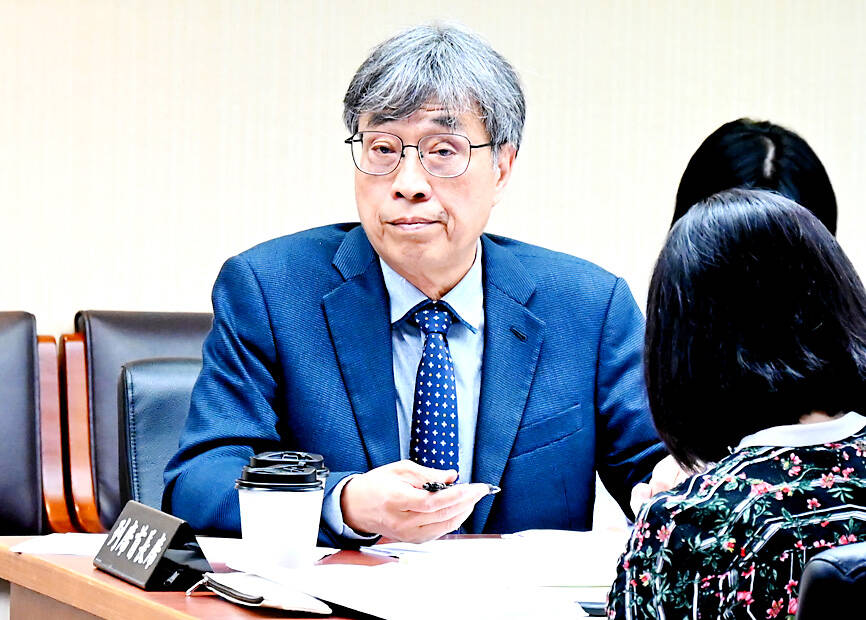The Ministry of Agriculture is launching a series of measures to boost the demand for Taiwan-
produced fresh milk to minimize the impact of the removal of tariffs on dairy products imported from New Zealand from 2025.
The zero-tariff policy for dairy products imported from New Zealand is part of an economic cooperation agreement between Taiwan and New Zealand, called ANZTEC, which was signed on July 10, 2013.

Photo: Chu Pei-hsiung, Taipei Times
At a joint meeting of four legislative committees yesterday, Chinese Nationalist Party (KMT) Legislator Lee De-wei (李德維) asked Acting Minister of Agriculture Chen Junne-jih (陳駿季) how the policy would affect the domestic fresh milk market.
“We have been holding talks with dairy farming industry representatives in the past year... The most important thing is to increase the demand for Taiwan-produced milk and distinguish it from milk imported from other countries,” Chen said.
The agricultural industry is redesigning the label for Taiwan-produced fresh milk and has developed the technology to identify any mixture of domestically produced milk and imported milk, he said.
Lee said the ministry should consider not calling imported liquid milk “fresh milk” to distinguish it from locally produced milk.
Chen said that the quality of Taiwan-produced fresh milk, as well as its low-carbon emission production process, should be recognized and affirmed by domestic consumers, which is a better way to distinguish between these two types of milk.
Chen told a meeting of the Economics Committee on Wednesday last week that the ministry is seeking approval from the Executive Yuan for a proposal to establish a four-year dairy farming industry development fund to mitigate the impact that the new policy might have on the domestic dairy farming industry.
The funding would be used to upgrade the local dairy farming industry, create demand for domestically produced dairy products and facilitate sales of these products, he said.
“We need to review the size of dairy cattle. Of the roughly 125,000 dairy cows in the country, 12,000 sick and weak ones are to be retired,” he said.
“We will seek to reduce the costs that dairy farmers spend to buy forage grass and incorporate the weather forecast system into the grass-drying process,” he said.
“We will also monitor the quality of domestically produced milk, coordinate the pricing scheme between ranches and dairy plants, reduce carbon emissions during the production process and facilitate the sales of domestically produced milk,” he added.
To boost demand for Taiwan-made dairy products, the government would increase the supply of fresh milk to school-age children and elderly people in farming and fishing villages, Chen said.
There would also be a traceability system for Taiwan-made dairy products, it said.
Some dairy farmers have suggested that the ministry intervene and help lower shelf placement fees for domestically produced dairy products in supermarkets or larger retail chains, as the fees generally account for 30 to 50 percent of retail prices.
“Pricing strategies for dairy products are determined based on various contracts between dairy plants and supermarkets, and it would be difficult for the government to intervene,” Chen said.

NUMBERS IMBALANCE: More than 4 million Taiwanese have visited China this year, while only about half a million Chinese have visited here Beijing has yet to respond to Taiwan’s requests for negotiation over matters related to the recovery of cross-strait tourism, the Tourism Administration said yesterday. Taiwan’s tourism authority issued the statement after Chinese-language daily the China Times reported yesterday that the government’s policy of banning group tours to China does not stop Taiwanese from visiting the country. As of October, more than 4.2 million had traveled to China this year, exceeding last year. Beijing estimated the number of Taiwanese tourists in China could reach 4.5 million this year. By contrast, only 500,000 Chinese tourists are expected in Taiwan, the report said. The report

Temperatures are forecast to drop steadily as a continental cold air mass moves across Taiwan, with some areas also likely to see heavy rainfall, the Central Weather Administration (CWA) said. From today through early tomorrow, a cold air mass would keep temperatures low across central and northern Taiwan, and the eastern half of Taiwan proper, with isolated brief showers forecast along Keelung’s north coast, Taipei and New Taipei City’s mountainous areas and eastern Taiwan, it said. Lows of 11°C to 15°C are forecast in central and northern Taiwan, Yilan County, and the outlying Kinmen and Lienchiang (Matsu) counties, and 14°C to 17°C

SHIPS, TRAINS AND AUTOMOBILES: The ministry has announced changes to varied transportation industries taking effect soon, with a number of effects for passengers Beginning next month, the post office is canceling signature upon delivery and written inquiry services for international registered small packets in accordance with the new policy of the Universal Postal Union, the Ministry of Transportation and Communications said yesterday. The new policy does not apply to packets that are to be delivered to China, the ministry said. Senders of international registered small packets would receive a NT$10 rebate on postage if the packets are sent from Jan. 1 to March 31, it added. The ministry said that three other policies are also scheduled to take effect next month. International cruise ship operators

STEERING FAILURE: The first boat of its class is experiencing teething issues as it readies for acceptance by the navy, according to a recent story about rudder failure The Hai Kun (海鯤), the nation’s first locally built submarine, allegedly suffered a total failure of stern hydraulic systems during the second round of sea acceptance trials on June 26, and sailors were forced to manually operate the X-rudder to turn the submarine and return to port, news Web site Mirror Daily reported yesterday. The report said that tugboats following the Hai Kun assisted the submarine in avoiding collisions with other ships due to the X-rudder malfunctioning. At the time of the report, the submarine had completed its trials and was scheduled to begin diving and surfacing tests in shallow areas. The X-rudder,